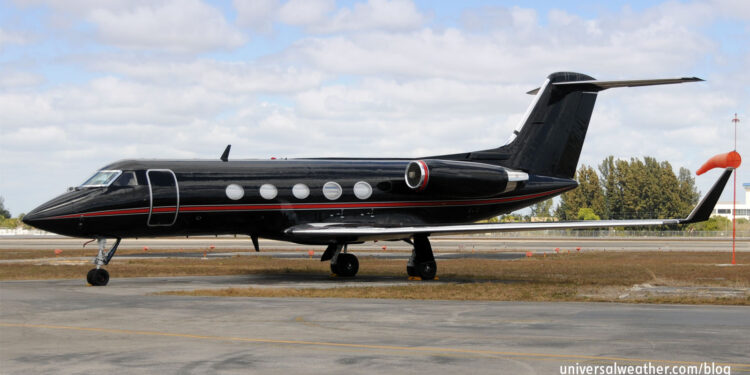China Overflight and Landing Permits – Part 2: Permit Considerations

This is a post by author Jimmy Young. Jimmy serves as the country manager for Universal Aviation China, which has aircraft ground handling facilities in Beijing, Shanghai, and Guangzhou. Jimmy is an expert on business aircraft operations in China and can be contacted at jimmyyoung@universalaviation.aero.
This business aviation blog post continues from our article last week, titled “China Overflight and Landing Permits – Part 1: Changes in Lead Times and Revisions.”
Business aircraft operators planning flights to domestic and/or military airports in China are subject to longer lead times than those applicable to Airports of Entry (AOEs). It’s important to be mindful of airport slot requirements and peak operating hour limitations at busier airfields in China.
The following is an overview of what you need to know:
1. Longer permit lead times are required for landing at domestic airports
In China, landing permit lead time is seven business days for operations to military or domestic-only airports, and there are particular requirements to be mindful of. For any operation to non-AOEs, you must submit the purpose of your trip and provide two sponsor letters – one from a local government entity and the other from your business contact. Once a permit for a military or domestic-only airport has been approved, no revisions will be accepted. Additionally, you’ll most likely require a local navigator to travel with you into/out of these airports.
2. Civil Aviation Administration China may change approved slots
Be aware that the Civil Aviation Administration China (CAAC), at its discretion, may change your approved arrival slot at any time prior to the estimated time of arrival. The likelihood of CAAC changing the slot isn’t high, but authorities do re-assign airport slots from time to time based on traffic congestion at the appropriate airport.
3. CAAC operating hours
Normal CAAC operating hours are Monday-Friday, 0800-1600 local, and the agency is closed on holidays. After hours, CAAC personnel are on duty, but they’ll only process emergency and medical emergency requests outside normal operating hours.
4. Requests must be transmitted to CAAC via SITA
All permit and revision requests for foreign-registered operators must be transmitted to CAAC via SITA. For mainland China registered-aircraft, permit requests/revisions may be transmitted via either SITA or fax.
5. Considerations for planning a tech stop in China
Tech stops are only permitted at a handful of airports in China – including Urumqi (ZWWW). CAAC will only approve tech stops for fuel uplift – no crew or passengers may embark/disembark. While airport and immigration authorities will monitor your flight, no CIQ clearance is needed, and no visas are required. Prior to planning tech stops in China, it’s best to check with your 3rd-party provider or ground handler on which airports will approve tech stops.
6. Only five stops are permitted in China
Landing permits allow an operator to travel to no more than five locations in China. If you intend to make more than five stops within the country, you’ll need to leave China, with your aircraft, and return with a new landing permit.
7. Airport slot requirements
At this time, only five major airports in China enforce airport slot requirements. These include Capital Beijing (ZBAA), Pudong Shanghai (ZSPD), Guangzhou (ZGGG), Hongqiao Shanghai (ZSSS), and Shenzhen (ZGSZ). Note that a GA aircraft may not occupy more than two peak-hour slots at any airport in China that has airport slot requirements. Peak hours for scheduled commercial activity are generally 0700-2300 local.
8. Flight plan requirements
For operations to China, flight plans should be filed at least six hours in advance. It’s recommended that your flight plan be filed at least two hours prior to departure from China.
9. Operations to/from Taiwan
At this time, only aircraft registered to Taiwan or mainland China (not including Hong Kong or Macau registrations) may operate directly between the two countries. For all other operators, that means that if you’re traveling between China and Taiwan, you must make a stop in a third country or at either Hong Kong (VHHH) or Macau (VMMC).
10. Additional operating considerations
When operating to China, it’s important to ensure that all crew members and passengers have correct and valid Chinese visas. Anyone on board who does not have the proper or required visa will be deported.
Be aware, also, that all foreign-registered aircraft are charged a compensation fee when traveling to China. This is meant to compensate for business that general aviation takes away from local commercial airlines. The only operators not required to pay this fee are those with mainland China-registered aircraft.
Closing thoughts
When planning a flight to China, it’s always best to start the process a week or two in advance and ensure that you have all required documentation, sponsor letters, and visas. Be careful not to request more than two peak-hour airport slots at slot-restricted locations, and be mindful of the two-revision limitation when contemplating schedule or permit changes.
Questions?
If you have any questions about this article or would like assistance planning your next trip to China, contact Christine Vamvakas christinevamvakas@univ-wea.com.




